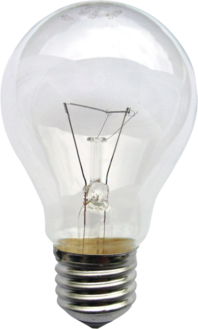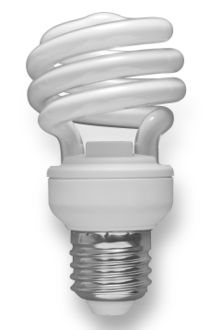Lumen
The lumen (lm) is the SI derived unit for light flux, which is the amount of light being received by a surface.[1] A lumen is defined as the amount of light being emitted into 1 unit of solid angle (1/4π of the area of a sphere) by a light source with a luminous intensity of 1 candela. Therefore a source of 1 candela will be putting out a total of 4π lumens.[1]
- Both bulbs emit 800 lumens, however the CFL bulb uses less power to do so.
Incandescent bulb: Requires 60 watts of power.[2]
CFL bulb: Requires 13 watts of power.[3]
Light bulbs are often rated in lumens in order to communicate their brightness. For example, a 13 watt CFL light bulb and a 60 watt incandescent light bulb have the same brightness of 800 lumens, therefore the CFL bulb accomplishes the same goal while using less power.[4][5]
Lux
Lumens can be thought of as the "amount" of light within a beam or angle given off by a source, however it doesn't explain how much light will arrive at any given distance from the source. The unit for this is lux, which is equal to 1 lumen per square meter. A full moon on a clear night is tremendously bright (high lumen value), however the lux received on the Earth is about 1/4 of a lumen per square meter. In comparison, a light bulb will have an illumination of approximately 50 lux, while direct sunlight can get up to 130,000 lux at the Earth's surface.[6]
References
- ↑ 1.0 1.1 Rowlett Unit Dictionary. (Accessed Sept. 4, 2015). lumen (lm) [Online], Available: http://www.unc.edu/~rowlett/units/dictL.html#lumen
- ↑ Wikimedia Commons [Online], Available: https://upload.wikimedia.org/wikipedia/commons/3/3a/Gluehlampe_01_KMJ.jpg
- ↑ Wikimedia Commons [Online], Available: https://upload.wikimedia.org/wikipedia/commons/3/31/06_Spiral_CFL_Bulb_2010-03-08_(white_back).jpg
- ↑ Energy Star. (Accessed Sept 4, 2015). Learn about brightness [Online], Available: http://www.energystar.gov/index.cfm?c=cfls.pr_cfls_lumens
- ↑ Natural Resources Canada. (Accessed Sept 3, 2015). Facts About Compact Fluorescent Light Bulbs [Online], Available: http://www.nrcan.gc.ca/sites/oee.nrcan.gc.ca/files/files/pdf/equipment/CFL_Facts_e.pdf
- ↑ SI Units Explained. (Accessed Sept 4, 2015). Luminous Intensity [Online], Available: http://www.si-units-explained.info/luminosity/



